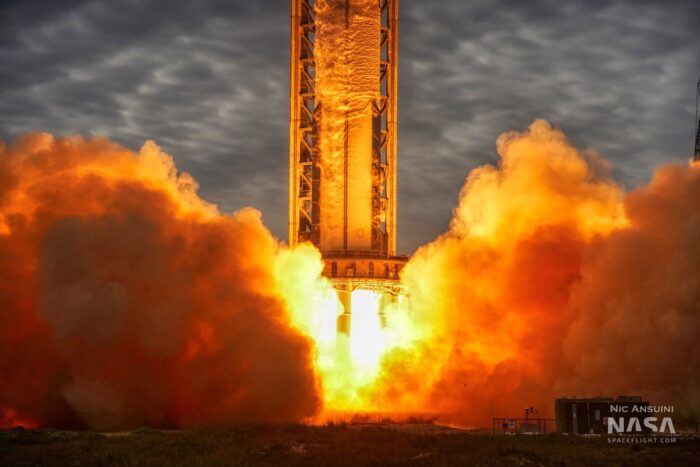Feb 14 2023
SpaceX Tests Super Heavy Booster
 Last Thursday SpaceX successfully conducted the most significant test firing of its Heavy Booster rocket to date. The rocket sports 33 Raptor 2 engines. During the test, 31 of them fired. One engine failed, and one was shut down. According to SpaceX, even with 31 engines the rocket would still make it to Earth orbit.
Last Thursday SpaceX successfully conducted the most significant test firing of its Heavy Booster rocket to date. The rocket sports 33 Raptor 2 engines. During the test, 31 of them fired. One engine failed, and one was shut down. According to SpaceX, even with 31 engines the rocket would still make it to Earth orbit.
The test moves SpaceX one step closer to a full launch of the Starship system, which includes a Starship on top of a Heavy Booster. On Thursday’s test they fired Booster 7, which is currently pared with Ship 24, however during the test they only had Booster 7 on the pad in case of catastrophic failure. If the analysis of this test turns out well SpaceX plans to launch a full stack, booster plus ship, into orbit either later this month or next month.
SpaceX says it has two full stacks ready to go, but there are many more in various stages of assembly. They expect to produce an additional pair of boosters and ships every two months. Further, both components are fully reusable, which means they can fly multiple times. It remains to be seen, of course, what their lifespan will be – how many times can each component fly?
If all goes well, and it’s looking good so far, this will be a significant addition to our spaceflight capability. The Starship system will be the most powerful rocket ever launched – more powerful than the Saturn V, then NASA’s current Space Launch System (SLS) and even the most powerful Soviet/Russian rocket ever developed. It will have a lift capacity of 100-150+ tons, depending on the desired orbit. The Starship could also be configured to carry 100 crew/passengers.
Whey is SpaceX developing this system? One reason is to drive down the cost of getting stuff into orbit. We won’t know the true cost until the rockets are actually taking stuff to orbit and we see what the total maintenance costs are and how reusable they are. But the estimates are between $1,500 and $2,500 per kg of cargo to LEO. That is amazing. Costs of getting things into orbit were >$100,000 at the beginning of the Space Shuttle program. Costs dramatically decreased throughout that program, getting down to about $54,000 per kg. Commercial rockets between 1970 and 2000 have averaged about $18,000 per kg. SpaceX has decreased prices further with their reusable rockets, down to about $5,000 per kg. Starship will continue that trend.
Compare this to the SLS system. The Artemis program will have a capacity to launch one rocket per year, and that rocket is not reusable. This will cost about $4 billion per launch. This is not a sustainable system – it was never meant to be. It was meant to get us back to the moon. It’s an impressive system, but it was over budget and years delayed (like most such programs). SpaceX has taken a completely different approach. The Starship was designed to be cost-effective and reusable, to be a sustainable system for getting lots of stuff and people into space.
Which leads me to the next question – what is the Starship really for? SpaceX wants the Starship system to be versatile also, having multiple possible applications. Conventionally it can be used to get lots of stuff cheaply into LEO. That will likely be its primary function for a while, and essentially pay for the program. But the ship is also powerful enough for deep space. This means it can get to the Moon. Whether or not it will be used for this purpose depends on how well the Artemis program goes. If we want a permanent presence on the moon, something like Starship will be essential. SpaceX has also contracted with NASA to repurpose the Starship to be their lunar lander (I am still not sure how this will work).
SpaceX also says that the Starship can be configured for point-to-point travel on Earth, taking 100 passengers from New York to Tokyo, for example, in 45 minutes. I personally doubt this will ever happen, other than as, perhaps, a demonstration. It’s always hard to predict these things, but if I had to I would say there would not be enough of a market to make this application profitable.
This leaves the other deep space destination – Mars. The Starship is powerful enough to take cargo and people to Mars. Musk has declared that he wants humanity to be a “multi-planet species”. There is still a lot of skepticism about the ability to maintain a settlement on Mars. It certainly will be extremely challenging, and we basically can’t do it right now. Even getting people to Mars will be tricky, just considering the radiation exposure. Once on the surface of Mars there is more radiation exposure.
As I have discussed before, we need to develop multiple technologies to make a Mars settlement sustainable, but they are all doable. I don’t know if the Starship system will be the one to get us to Mars when we are eventually ready to go there, but it might be.
Either way – Starship appears to be on the brink of launching into orbit. When it does that will mean a significant increase in our spacefaring capacity.






